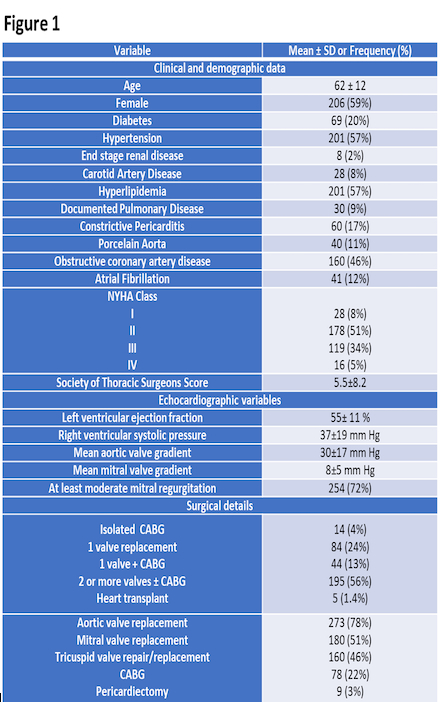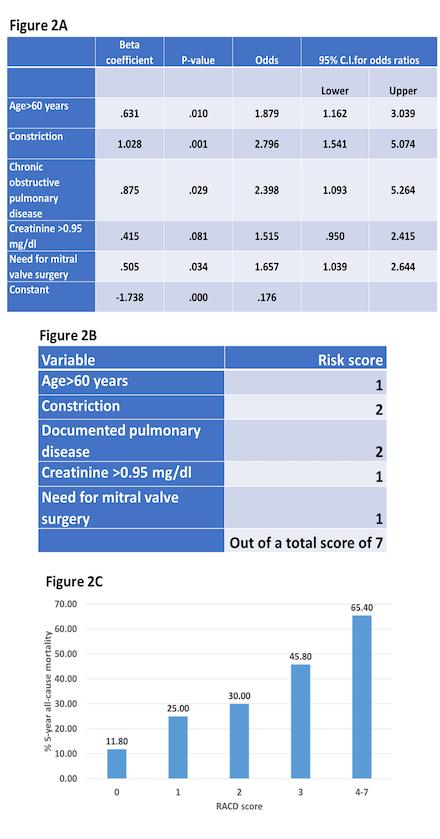Final ID: Mo4161
Outcomes of Patients with Radiation-Associated Cardiac Disease Undergoing Cardiothoracic Surgery: Development of a Disease Specific Risk Score
Abstract Body (Do not enter title and authors here): Background
Radiation-associated cardiac disease (RACD) has significant long-term mortality and morbidity, often requiring cardiac surgery(CS).
Hypothesis
We sought to study factors associated with longer-term survival in RACD patients and develop a specific risk score associated with 5-year survival following CS.
Methods
This was an observational cohort study of 351 patients with documented RACD (252 [72%] had mantle radiation for lymphoma at a mean of 18 years prior), who underwent CS at a tertiary care center between 1991-2018. Clinical characteristics were collected, and Society of Thoracic Surgeons (STS) score was calculated. The primary endpoint was mortality. Multivariable analysis for 5-year mortality was performed using age, sex, history of lymphoma, New York Heart Association class, prior cardiac surgery, atrial fibrillation, constriction, chronic pulmonary disease, serum creatinine, left ventricular ejection fraction, right ventricular systolic pressure and valvular surgery(aortic, mitral or tricuspid).
Results
Clinical characteristics are shown in Figure 1. Mean follow-up was 6.2±4.6 years & 5-year mortality occurred in 123 (35%) patients (7 [2%] in-hospital deaths). Cox 5-year survival analysis results are shown in Figure 2A. A receiver operator curve analysis for 5-year mortality showed an area under curve of 0.70 (95% confidence interval 0.64-76, p<0.001). Subsequently, a 5-year risk score (0-7 points) was generated (Figure 2 A); with an increasing risk of mortality at 5 years, based on increasing risk score (Figure 2C). Cardiac reoperation was not associated with worse outcomes.
Conclusion
RACD patients undergoing CTS have a high rate of 5-year mortality, despite a low baseline STS score & perioperative mortality. A novel RACD-specific risk score (incorporating higher age, abnormal renal/pulmonary, constrictive pericarditis & need for concomitant mitral valve surgery) provides good discrimination for 5-year survival & could be used for shared-decision making.
Radiation-associated cardiac disease (RACD) has significant long-term mortality and morbidity, often requiring cardiac surgery(CS).
Hypothesis
We sought to study factors associated with longer-term survival in RACD patients and develop a specific risk score associated with 5-year survival following CS.
Methods
This was an observational cohort study of 351 patients with documented RACD (252 [72%] had mantle radiation for lymphoma at a mean of 18 years prior), who underwent CS at a tertiary care center between 1991-2018. Clinical characteristics were collected, and Society of Thoracic Surgeons (STS) score was calculated. The primary endpoint was mortality. Multivariable analysis for 5-year mortality was performed using age, sex, history of lymphoma, New York Heart Association class, prior cardiac surgery, atrial fibrillation, constriction, chronic pulmonary disease, serum creatinine, left ventricular ejection fraction, right ventricular systolic pressure and valvular surgery(aortic, mitral or tricuspid).
Results
Clinical characteristics are shown in Figure 1. Mean follow-up was 6.2±4.6 years & 5-year mortality occurred in 123 (35%) patients (7 [2%] in-hospital deaths). Cox 5-year survival analysis results are shown in Figure 2A. A receiver operator curve analysis for 5-year mortality showed an area under curve of 0.70 (95% confidence interval 0.64-76, p<0.001). Subsequently, a 5-year risk score (0-7 points) was generated (Figure 2 A); with an increasing risk of mortality at 5 years, based on increasing risk score (Figure 2C). Cardiac reoperation was not associated with worse outcomes.
Conclusion
RACD patients undergoing CTS have a high rate of 5-year mortality, despite a low baseline STS score & perioperative mortality. A novel RACD-specific risk score (incorporating higher age, abnormal renal/pulmonary, constrictive pericarditis & need for concomitant mitral valve surgery) provides good discrimination for 5-year survival & could be used for shared-decision making.
More abstracts on this topic:
A New Biomarker of Aging Derived From Electrocardiogram Improves Risk Prediction of Incident Myocardial Infarction and Stroke.
Wilsgaard Tom, Rosamond Wayne, Schirmer Henrik, Lindekleiv Haakon, Attia Zachi, Lopez-jimenez Francisco, Leon David, Iakunchykova Olena
“Atrialized” Minimally Invasive Transcatheter Mitral Valve-In-MAC Replacement to Prevent Outflow Tract ObstructionSteafo Lark, Smielewski Mitchell, Madanat Luai, Bloomingdale Richard, Jabri Ahmad, Gallagher Michael, Birk Vishal, Abbas Amr, Young John, Suri Rakesh


